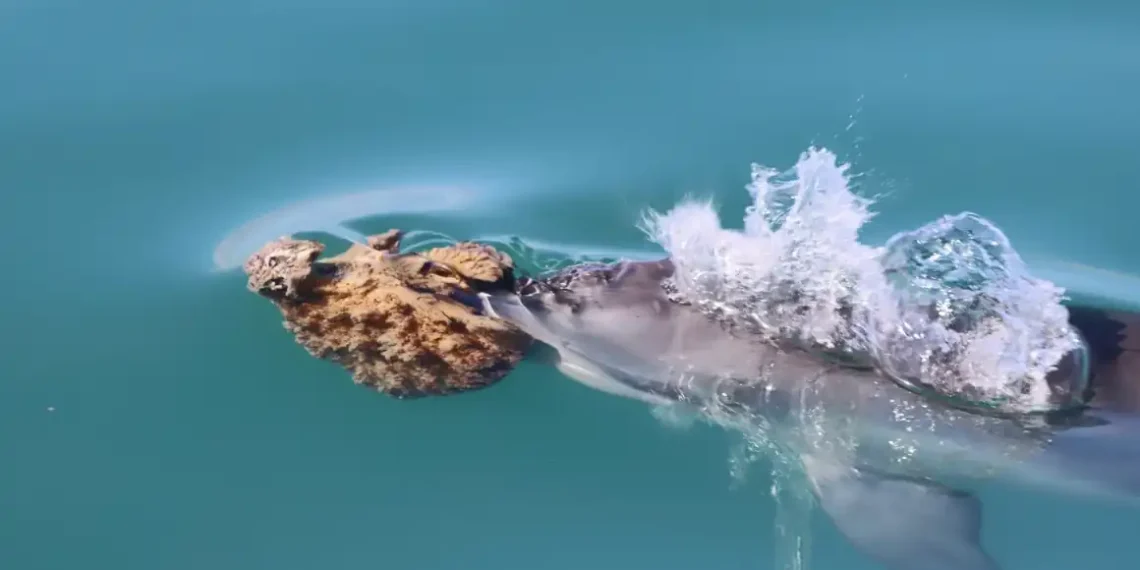Some dolphins in Australia have developed a unique way to catch fish — using sea sponges as tools.
How Australian Dolphins Use Sponges to Hunt Fish — And Why It’s So Hard to Learn
This rare behavior is passed down from mother to calf and takes years to master. But as scientists found, using a sponge to hunt isn’t easy. It affects the dolphin’s natural ability to “see” with sound, making the technique even more impressive.
Here’s what researchers discovered about these clever marine mammals — and why only a few are able to learn the trick.
What Is “Sponging” and Why Do Dolphins Do It?
In Shark Bay, Australia, a small group of bottlenose dolphins has been observed using marine sponges as hunting tools. These dolphins place cone-shaped sponges on their beaks, like a nose cover, before diving to the seafloor.
The sponge protects their sensitive skin from sharp rocks and rough sand while they dig into the seabed. As they stir up the bottom, small fish — especially a type called barred sandperch — get flushed out and become easy targets.
The sponges they use vary in size, from about as big as a softball to the size of a cantaloupe.
A Skill That’s Harder Than It Looks
Although the sponge acts like armor for the dolphins’ beaks, it also creates a challenge. Bottlenose dolphins rely heavily on echolocation to hunt — sending out clicking sounds and listening for the echoes that bounce back. This allows them to “see” their surroundings with sound, especially in murky waters.
But the sponge muffles those sound waves.
“It has a muffling effect in the way that a mask might,” said Ellen Rose Jacobs, a marine biologist at the University of Aarhus in Denmark and one of the study’s authors. “Everything looks a little bit weird, but you can still learn how to compensate.”
Jacobs used underwater microphones to confirm that the dolphins were still using echolocation while sponging. She then modeled how much the sponge distorted their sound waves.
Why Only a Few Dolphins Learn It
Sponge-hunting is not common among dolphins — and now scientists better understand why.
“It’s like hunting while blindfolded,” said Mauricio Cantor, a marine biologist at Oregon State University who wasn’t part of the study. “You’ve got to be very good, very well-trained to pull it off.”
Only about 5% of the Shark Bay dolphin population — roughly 30 individuals — use this technique, according to the study. That small number may be due to how long it takes to learn the skill and how tricky it is to perform.
“It takes them many years to learn this special hunting skill — not everybody sticks with it,” said marine ecologist Boris Worm of Dalhousie University in Canada, who was also not involved in the research.
A Learned Behavior Passed From Mother to Calf
Dolphin calves stay with their mothers for three to four years — a time when they watch, follow, and learn how to survive in the wild. Sponge hunting is one of the rare examples of tool use in marine animals, and researchers say it’s passed down only from mother to offspring.
“This kind of behavior is only ever passed down from mother to offspring,” said Janet Mann, a Georgetown University marine biologist and co-author of the study.
That long learning period may help explain why the skill doesn’t spread quickly among dolphins. If a dolphin doesn’t learn it early, it likely never will.
A Glimpse Into Dolphin Intelligence
Scientists have long known that dolphins are intelligent and social creatures. But this study highlights just how advanced some of their behaviors can be — including the use of tools and the ability to adapt when their natural senses are challenged.
For the few dolphins that master sponge hunting, it’s a clever and effective way to catch a meal in the wild. And it gives researchers one more fascinating example of how animals pass on knowledge across generations.
This article was rewritten by JournosNews.com based on verified reporting from trusted sources. The content has been independently reviewed, fact-checked, and edited for accuracy, neutrality, tone, and global readability in accordance with Google News and AdSense standards.
All opinions, quotes, or statements from contributors, experts, or sourced organizations do not necessarily reflect the views of JournosNews.com. JournosNews.com maintains full editorial independence from any external funders, sponsors, or organizations.
Stay informed with JournosNews.com — your trusted source for verified global reporting and in-depth analysis. Follow us on Google News, BlueSky, and X for real-time updates.














